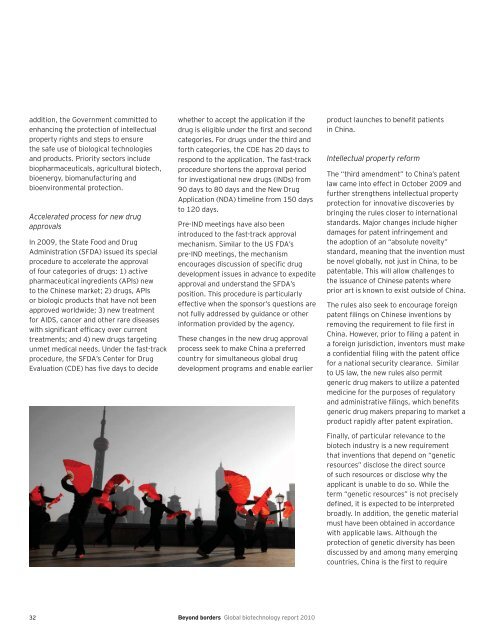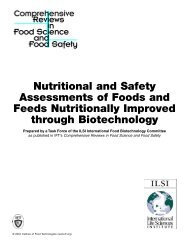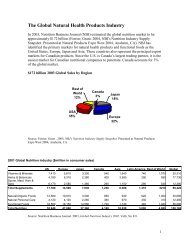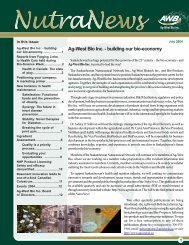Beyond Borders: Global biotechnology report 2010
Beyond Borders: Global biotechnology report 2010
Beyond Borders: Global biotechnology report 2010
Create successful ePaper yourself
Turn your PDF publications into a flip-book with our unique Google optimized e-Paper software.
addition, the Government committed to<br />
enhancing the protection of intellectual<br />
property rights and steps to ensure<br />
the safe use of biological technologies<br />
and products. Priority sectors include<br />
biopharmaceuticals, agricultural biotech,<br />
bioenergy, biomanufacturing and<br />
bioenvironmental protection.<br />
Accelerated process for new drug<br />
approvals<br />
In 2009, the State Food and Drug<br />
Administration (SFDA) issued its special<br />
procedure to accelerate the approval<br />
of four categories of drugs: 1) active<br />
pharmaceutical ingredients (APIs) new<br />
to the Chinese market; 2) drugs, APIs<br />
or biologic products that have not been<br />
approved worldwide; 3) new treatment<br />
for AIDS, cancer and other rare diseases<br />
with significant efficacy over current<br />
treatments; and 4) new drugs targeting<br />
unmet medical needs. Under the fast-track<br />
procedure, the SFDA’s Center for Drug<br />
Evaluation (CDE) has five days to decide<br />
whether to accept the application if the<br />
drug is eligible under the first and second<br />
categories. For drugs under the third and<br />
forth categories, the CDE has 20 days to<br />
respond to the application. The fast-track<br />
procedure shortens the approval period<br />
for investigational new drugs (INDs) from<br />
90 days to 80 days and the New Drug<br />
Application (NDA) timeline from 150 days<br />
to 120 days.<br />
Pre-IND meetings have also been<br />
introduced to the fast-track approval<br />
mechanism. Similar to the US FDA’s<br />
pre-IND meetings, the mechanism<br />
encourages discussion of specific drug<br />
development issues in advance to expedite<br />
approval and understand the SFDA’s<br />
position. This procedure is particularly<br />
effective when the sponsor’s questions are<br />
not fully addressed by guidance or other<br />
information provided by the agency.<br />
These changes in the new drug approval<br />
process seek to make China a preferred<br />
country for simultaneous global drug<br />
development programs and enable earlier<br />
32 <strong>Beyond</strong> borders <strong>Global</strong> <strong>biotechnology</strong> <strong>report</strong> <strong>2010</strong><br />
product launches to benefit patients<br />
in China.<br />
Intellectual property reform<br />
The “third amendment” to China’s patent<br />
law came into effect in October 2009 and<br />
further strengthens intellectual property<br />
protection for innovative discoveries by<br />
bringing the rules closer to international<br />
standards. Major changes include higher<br />
damages for patent infringement and<br />
the adoption of an “absolute novelty”<br />
standard, meaning that the invention must<br />
be novel globally, not just in China, to be<br />
patentable. This will allow challenges to<br />
the issuance of Chinese patents where<br />
prior art is known to exist outside of China.<br />
The rules also seek to encourage foreign<br />
patent filings on Chinese inventions by<br />
removing the requirement to file first in<br />
China. However, prior to filing a patent in<br />
a foreign jurisdiction, inventors must make<br />
a confidential filing with the patent office<br />
for a national security clearance. Similar<br />
to US law, the new rules also permit<br />
generic drug makers to utilize a patented<br />
medicine for the purposes of regulatory<br />
and administrative filings, which benefits<br />
generic drug makers preparing to market a<br />
product rapidly after patent expiration.<br />
Finally, of particular relevance to the<br />
biotech industry is a new requirement<br />
that inventions that depend on “genetic<br />
resources” disclose the direct source<br />
of such resources or disclose why the<br />
applicant is unable to do so. While the<br />
term “genetic resources” is not precisely<br />
defined, it is expected to be interpreted<br />
broadly. In addition, the genetic material<br />
must have been obtained in accordance<br />
with applicable laws. Although the<br />
protection of genetic diversity has been<br />
discussed by and among many emerging<br />
countries, China is the first to require








